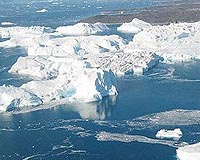 |
Beijing (AFP) June 30, 2010 A Chinese research vessel and ice-breaker is due to set sail this week for the Arctic, a region much coveted by Beijing for its wealth of scientific data and natural resources. The shrinking of the frozen sheets blanketing the Arctic -- thanks to global warming -- are expected, at least in summer, to allow navigation of the area and access to its as-yet untapped supplies of oil and natural gas. Indeed, studies show the Arctic could be completely ice-free in summer by 2050 or earlier, making it an object of desire, and dispute, for the countries which border it -- Russia, Norway, the United States, Canada and Denmark. China, which has no territorial claim whatsoever, "is indeed at a very disadvantageous position in this brewing international competition surrounding the Arctic passage and resources", said Ren Xianfang, of IHS Global Insight. Passage through the Arctic would shorten the route from Shanghai to Hamburg by 6,400 kilometres (4,000 miles) and limit exploding insurance costs sparked by the pirates infesting the waters of the Gulf of Aden, according to a study by the Stockholm International Peace Research Institute (SIPRI). But there are possible pitfalls for a future Chinese waterway, such as the difficulty of navigating between icebergs and the competing claims for right-of-way of the bordering countries. The advantages of opening up the Arctic are far more than geographical. Both its hard-to-reach deep waters and those nearer the shore are believed to contain up to 13 percent of the world's untapped oil reserves and up to 30 percent of its undiscovered natural gas deposits, according to the US Geological Survey. "There are indisputably high stakes for China in the Arctic, considering that the country's economy is connecting increasingly closely with North America and Europe," said Ren, the Global Insight researcher. "A shorter shipping route to these two destinations will certainly cut logistics expenses, increase the competitiveness of China's manufactured products and provide a boon to China's external sector." Ren said China's appetite for overseas resources would only increase in the future as its own reserves dwindle. "China, as a rising global power, is having a much larger say in international affairs now, and it will probably be able to leverage that influence to weigh itself in the shaping of the future Arctic global governance mechanism," she added. China, already an ad-hoc observer of the Council of the Arctic States, is seeking permanent observer status. "China does not want to be a challenger in the world order and has a cautious approach," said Guo Peiqing, associate professor of polar politics and law at the Ocean University of China in Qingdao. "China's policy is mild, calm and non-aggressive." The author of the SIPRI study, Linda Jakobsen, said recently in Beijing that China "does not want to cause jitters and alarm... it does not have yet an official policy on the Arctic". Moreover, Beijing is adamant about respect for the principle of national sovereignty, and would not dispute the territorial rights of the Arctic states, she said. But that will not prevent China from getting its feet under the table, particularly in the field of scientific research -- hence the mission by icebreaker the Xuelong, which is set to begin on Thursday. According to Guo, China's interest in the Arctic is not just about oil -- it has a purely scientific interest in understanding the region, which plays a major role in determining China's climate and global climate change. "To get more privileges, more research is needed," Guo said. "To play an important role, it has to show it is specialised in Arctic research and is entitled to speak about the Arctic." Since 1999, Beijing has only set up one research station in the Arctic and carried out just three expeditions, compared with 26 in the Antarctic -- and three research stations -- since 1984. The new Arctic expedition will be the fourth for the Xuelong, an old Ukrainian cargo ship transformed into a floating laboratory known as "The Snow Dragon". But the government has decided to devote more resources to polar research and, in the years to come, Xuelong will get a little brother -- a smaller, high-tech ice-breaker.
Share This Article With Planet Earth
Related Links Beyond the Ice Age
 Arctic Ice At Low Point Compared To Recent Geologic History
Arctic Ice At Low Point Compared To Recent Geologic HistoryColumbus OH (SPX) Jun 04, 2010 Less ice covers the Arctic today than at any time in recent geologic history. That's the conclusion of an international group of researchers, who have compiled the first comprehensive history of Arctic ice. For decades, scientists have strived to collect sediment cores from the difficult-to-access Arctic Ocean floor, to discover what the Arctic was like in the past. Their most recent goal: ... read more |
|
| The content herein, unless otherwise known to be public domain, are Copyright 1995-2010 - SpaceDaily. AFP and UPI Wire Stories are copyright Agence France-Presse and United Press International. ESA Portal Reports are copyright European Space Agency. All NASA sourced material is public domain. Additional copyrights may apply in whole or part to other bona fide parties. Advertising does not imply endorsement,agreement or approval of any opinions, statements or information provided by SpaceDaily on any Web page published or hosted by SpaceDaily. Privacy Statement |